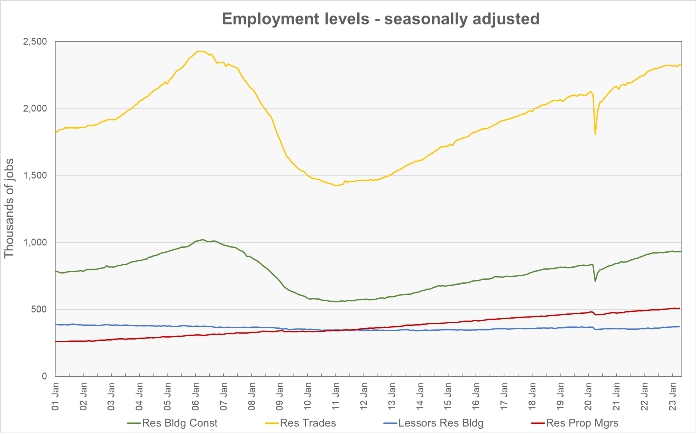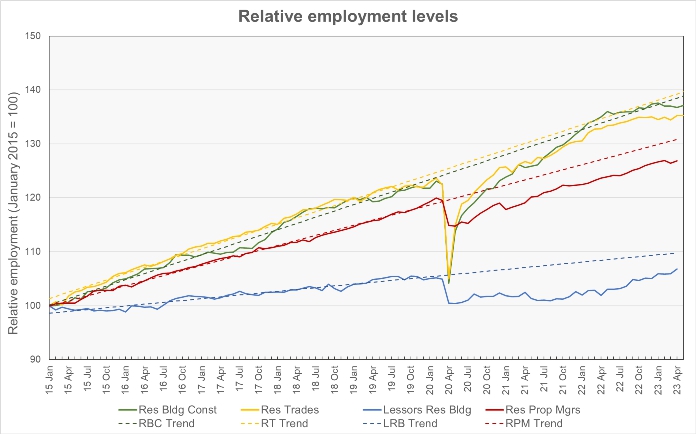The Employment Situation Report from the Bureau of Labor Statistics stated that apartment operations employment and residential construction employment both rose compared to their revised levels from the month before.
Total employment growth continues, or maybe not
The Bureau of Labor Statistics (BLS) reported that total non-farm employment increased by 239,000 jobs in May, based on their survey of business establishments. This compares to revised employment gains of 294,000 jobs in April and 217,000 jobs in March.
The BLS household survey reported that the U.S. unemployment rate rose to 3.7 percent, up from 3.4 percent last month. The household survey found that the number of employed persons fell by 310,000 from that reported last month while the number of unemployed persons rose by 440,000.
The household survey found that the number of people in the civilian labor force rose by 130,000 in May while the adult civilian population rose by 175,000. The labor force participation rate was unchanged at 62.6 percent. It had been at 63.4 percent before the pandemic. Recovering that 0.8 percent decline in the labor force participation rate would bring 2.1 million more people into the workforce.
The BLS did not specifically justify why the business survey would see employment rise by 239,000 while the household survey would see employment fall by 310,000. It noted that the business survey polls a larger number of respondents, so its result has less uncertainty than does that of the household survey. However, it also noted that the household survey includes more types of workers. These include self-employed workers with unincorporated businesses, unpaid family workers, agricultural workers, private household workers and people on unpaid leave. The business survey may also count one person with two jobs as two employed people. The household survey would not.
Tracking multifamily employment
The BLS reported more detailed employment information on four job categories of interest to the multifamily industry. These are employment as residential construction workers, as specialty trades within residential construction, as residential property managers and as lessors of residential buildings. As usual, some of the data is reported with a month delay, so the latest figures for the latter two categories are for the month of April.
The first chart shows the long-term history of the levels of employment in these four jobs categories.

Residential construction employment reported to rise
Employment in residential building construction in May, usually with general contractors, was reported to be up 2,400 jobs. The employment level for April was also revised higher by 300 jobs. Employment in this category is now 932,600 jobs, up 0.8 percent year-over-year and 11.4 percent higher than its level in February 2020.
Employment in residential building trades, i.e. plumbers, electricians, etc., in May was effectively unchanged with a reported rise of 100 jobs from April’s level. However, April’s employment level was revised downward by 4,100 jobs. Employment in this category is now 2,328,300 jobs, up 1.4 percent year-over-year and 9.4 percent above its level in February 2020.
Total March employment in these two categories of residential construction jobs combined was up 0.1 percent from the revised level of the month before. Residential construction employment was 9.9 percent above its level in February 2020.
Apartment operations jobs increase
Employment for residential property managers in April was reported to be up by 1,700 jobs (0.3 percent) from its revised (-900 jobs) level for March to 508,600 jobs. Employment for residential property managers is up 2.6 percent year-over-year and is up from its February 2020 level by 5.7 percent.
Employment for lessors of residential buildings was reported to rise in April by 2,900 jobs from March’s revised (-100 jobs) level to 373,300 jobs. Employment in this category is up 4.7 percent year-over-year and is now 1.5 percent above its pre-pandemic level.
Total employment in these two categories of apartment operations jobs combined was reported to be up 0.5 percent from the revised level for last month. It is now 4.2 percent above its level in February 2020.
Comparing to trend
The final chart, below, presents the employment data in a different format. It normalizes the employment levels in all four jobs categories to a reading of 100 for January 2015. It also provides trend lines for the growth in each of the categories of employment based on the period from January 2015 through February 2020.

The chart shows that employment in the residential building construction jobs category was the only one of the four that we track that recovered to a level above its trend line after the pandemic. However, in recent months, it has joined the other four in falling below trend. Residential building construction employment is now 1.3 percent below trend. Residential trades employment is now 3.2 percent below trend, residential property managers employment is 3.0 percent below trend and lessors of residential buildings employment is 2.7 percent below trend.
The numbers given in the Employment Situation report are seasonally adjusted and are subject to revision. It is common for small adjustments to be made in subsequent reports, particularly to the data for the most recent month. The current Employment Situation report can be found here.












